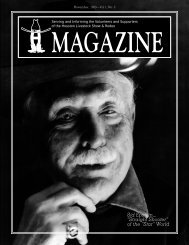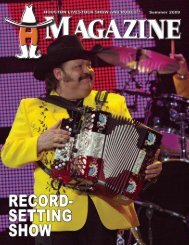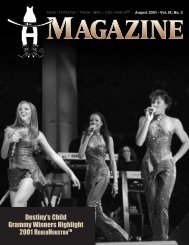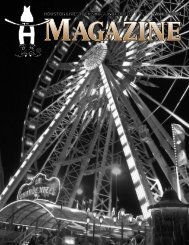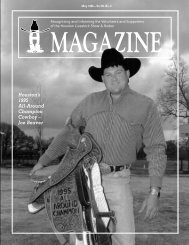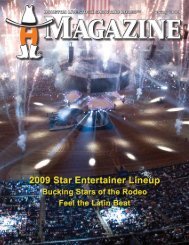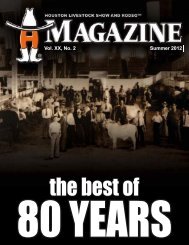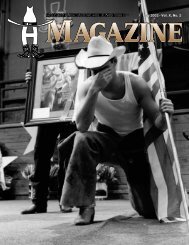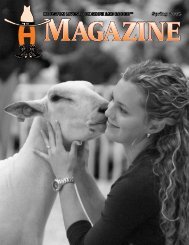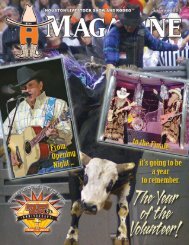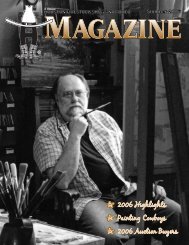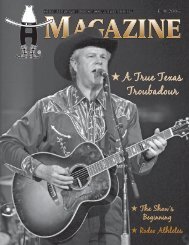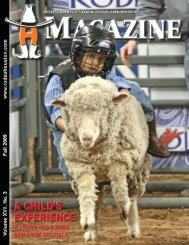magazine - Houston Livestock Show and Rodeo
magazine - Houston Livestock Show and Rodeo
magazine - Houston Livestock Show and Rodeo
Create successful ePaper yourself
Turn your PDF publications into a flip-book with our unique Google optimized e-Paper software.
Raising cattle <strong>and</strong> then moving them<br />
“on the hoof” from ranches to market<br />
points tested men’s spirit. Their peers<br />
<strong>and</strong> Anglo bosses alike admired these<br />
stock h<strong>and</strong>s of color for their hard work<br />
<strong>and</strong> mastery of ranching skills. With<br />
respect came both higher wages <strong>and</strong><br />
st<strong>and</strong>ards of living as compared to those<br />
who farmed the l<strong>and</strong> during this period<br />
of Jim Crow laws. Facing less prejudice,<br />
these cowboys gained positions of<br />
responsibility as ranch foremen <strong>and</strong><br />
managers. Because income was more<br />
consistent <strong>and</strong> higher than from sharecropping,<br />
<strong>and</strong> because Anglo ranchers<br />
sometimes paid ranch h<strong>and</strong>s with l<strong>and</strong><br />
or a share of the herd, black stock h<strong>and</strong>s<br />
were able to establish ownership of l<strong>and</strong><br />
<strong>and</strong> livestock more readily than sharecroppers.<br />
When rail transport of cattle brought<br />
an end to cattle drives, some unemployed<br />
drovers turned to different jobs,<br />
but others established small, self-owned<br />
ranches. Raising families, cattle <strong>and</strong><br />
crops was neither glamorous nor easy; it was a way of life. But, the<br />
cowboy tradition did not fade away, nor did the sense of competition,<br />
which continued to manifest itself in rodeo.<br />
<strong>Rodeo</strong>s have drawn people for a bit of recreation for generations.<br />
For some, rodeo life is a family tradition. Gary Richard, who<br />
ranks in the top 45 of the Professional Bull Riders, is a thirdgeneration<br />
competitor.<br />
Reflecting on family history, Richard recalled how his gr<strong>and</strong>father<br />
worked a ranching job in the ’30s <strong>and</strong> ’40s during the<br />
week <strong>and</strong> then competed in rodeos on weekends. He also recalled<br />
how, at some rodeos, blacks were not allowed to enter the competition,<br />
but instead had to wait until the end to compete among<br />
themselves <strong>and</strong> bet with the stock contractor to earn any money<br />
at all.<br />
Richard’s first professional ride came at age 14. He begged<br />
his father to let him ride in a local rodeo, but his dad<br />
brushed him off. Gathered around were his father’s friends,<br />
who passed the hat for the $10 entry fee. Relenting, his<br />
father permitted Richard to enter but didn’t tell his mother.<br />
Over the loudspeaker, the spectators heard that a “firsttime<br />
rider” was about to compete. Richard scored 74 points<br />
on bull number 10. When his mom heard the rodeo<br />
announcer call out her son’s name, she passed out. Still a<br />
competitor at 40 years old, he now watches his own 14-yearold<br />
son, Little Gary, ride bulls in youth rodeos.<br />
Although he is one of the few blacks in the PBR top<br />
45, Richard shares a bond with the other competitors. “On<br />
the circuit for 29 weeks — it is like one big family — we take<br />
care of each other <strong>and</strong> stick together. Cowboys got to stick<br />
together,” he said.<br />
Cowboys on the professional circuit today have advantages<br />
that their predecessors didn’t. For many, rodeo competition<br />
can be a full-time endeavor rather than a form of<br />
recreation. Six-time World Champion Calf Roper Fred<br />
Whitfield of Hockley, Texas; Lee Akin, a 28-year-old bull<br />
Thomas W. Jones, son of George Ranch founder Henry Jones, st<strong>and</strong>s with a group of stock h<strong>and</strong>s on<br />
horseback during the 1880s.<br />
rider from Weatherford, Okla.; <strong>and</strong> Leon Coffee, bullfighter,<br />
rodeo clown <strong>and</strong> entertainer extraordinaire from Wimberley,<br />
Texas, are just a few who make a career of rodeo life. They might<br />
make it look easy, but it doesn’t mean it is.<br />
From the 1800s to the 21st century, the values of hard work,<br />
sacrifice, honesty, dependability, showmanship, family <strong>and</strong> faith all<br />
have been part of the colorful history of the American cowboy.<br />
So, mamas, at RODEOHOUSTON, look around Reliant<br />
Stadium. How many spectators watching those cowboys <strong>and</strong><br />
cowgirls hold a dream not pursued? They sit there, imagining<br />
themselves riding into the sunset <strong>and</strong> hearing the refrain, “I<br />
should have been a cowboy; I should have learned to rope <strong>and</strong><br />
ride.” Go ahead. Let your babies grow up, knowing of the lives <strong>and</strong><br />
histories of those before them.<br />
Six-time World Champion Calf Roper Fred Whitfield always delights the crowd<br />
when he competes at RODEOHOUSTON.<br />
Photo courtesy George Ranch Historical Park, Richmond, Texas.<br />
7



